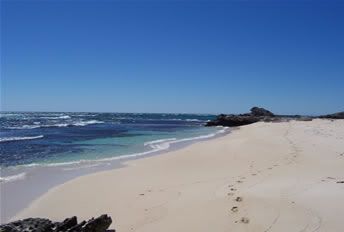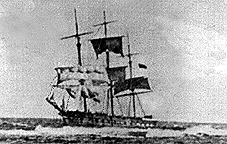
I was looking over some old posts today, and saw this photo again from the post I did recently about beaches. At first glance, it looks like a fairly normal (if stunningly beautiful) sandy beach. But looking at it I remembered a story I discovered about that beach, which is unimaginable when you simply look at the picture. This is City of York Bay on Rottnest Island, off the coast of Western Australia. I was wandering around the island and stopped here to eat my sandwich - after dodging the screeching seabirds that were obviously nesting nearby and were wheeling overhead. Those are my footprints, of course, and that black lump that breaks the horizon is actually a large craggy boulder with an Osprey nest on top. If you right-click the image and open it in a new window, you might just be able to make it out. I wasn't worried about the seagulls, but when the Osprey launched off from the nest and flew overhead, I scurried along out of range quickly. I think that's why my footprints start zigzagging around.
The other thing you can see from the picture is how pristine the beach is. Rottnest isn't exactly a crowded island, and this particular bay was off the beaten track enough that I saw nobody else the whole time I was there. The water is brilliantly clear, and you can see the volcanic-looking rocks in the water. These rocks are where the secret history of the beach starts, as I learned later that 137yrs ago 11 men were killed in that very water - drowning a hundred metres from the shore. Having sat there, I can't imagine people fighting for their lives in such a stunning setting. So after a bit of internet research, I found out the story of what happened.
On the 11th of July 1869 the 1,100 tonne iron barque City of York was approaching Fremantle docks, after sailing from San Francisco with a cargo of wooden doors and a crew of 26. The ship had crossed the Pacific in it's fastest recorded time, but as it approached Fremantle a heavy sea brewed, and blinding rain cut visibility dramatically. The Rottnest Lighthouse sent up a flare asking if the ship needed assistance. The man in charge of the City of York, Captain Jones, thought the flare had come from a pilot boat - so responded with a flare of his own before heaving the barque around and sailing towards the safety of the other ship. Tragically, the Lighthouse had sent up the wrong flare - and the unwitting Captain Jones was now steering directly towards it.
With the visbility almost nil, the ship's crew checked their depth and found they were in only 9m of water. Being so close to the reef, there was nothing they could do, and the City of York struck, and was swamped with water. Jones ordered the lifeboats out, but the ferocious waves overturned both of them almost immediately. Eight men managed to reboard the stricken ship, but the others were not so lucky. After four hours, seven had made it to shore - possibly on the very beach above. Two of them ran to the Lighthouse to raise the alarm. Eleven other crewmen - including Captain Jones - drowned. The next day a tugboat called Dunskey took three trips to rescue the eight survivors still on the wreck.
So that's the story behind the photo. At an inquiry, Captain Jones was criticised for 'gross carelessness and want of judgement', but after an appeal the actions of the Lighthouse keepers was questioned and the fault found with them. As a result, the shipping company was awarded £5000 damages, and the signalling system on Rottnest Island overhauled. The doors were later salvaged, and it was found that on the same night another ship - the Carlisle Castle - had been sunk in the storm, and a further 26 men killed. Today a small plaque marks the spot, which I walked past on my way back to Rottnest village to catch the ferry. I can't imagine what it must have been like on the day the City of York sank, as conditions were so very different to when I was there. I just couldn't comprehend that something so terrible had happened in a scene from a picture postcard.
Here's a second photo - taken in 1869. It's the City of York, before the waves broke it to pieces.

Further details on the sinking of the City of York can be found here.